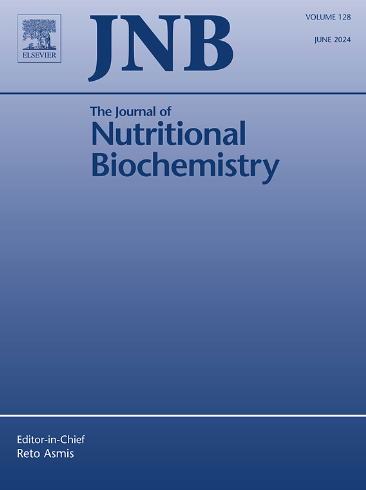建立可靠的啮齿类动物三甲胺n -氧化物状态的血液生物标志物:口服胆碱挑战、饮食胆碱和禁食条件的影响
IF 4.9
2区 医学
Q1 BIOCHEMISTRY & MOLECULAR BIOLOGY
引用次数: 0
摘要
肠道微生物-哺乳动物代谢物三甲胺n -氧化物(TMAO)的循环浓度与动脉粥样硬化风险有关。TMAO的生物合成始于膳食胆碱被肠道微生物TMA裂解酶转化为三甲胺(TMA)。TMA被运送到肝脏,在那里含黄素的单加氧酶将其转化为TMAO。虽然饮食改变可以调节氧化三甲胺的产生,但不同的摄入方式(包括口服灌胃、膳食补充以及禁食与非禁食等条件)的影响尚未得到充分探讨。雌性sd大鼠12只,分为无胆碱(0%胆碱)、低胆碱(0.08%胆碱)、高胆碱(1%胆碱)3组(每组 = 4只)。在两周不同胆碱饮食水平的饮食干预之前和之后,评估空腹和非空腹血中胆碱和氧化三甲胺的浓度,以及它们在急性胆碱挑战后的动力学。空腹胆碱受到严格控制,饮食胆碱的影响很小。非空腹胆碱变化更大,高饮食胆碱反映在较高的血胆碱。较高的饮食胆碱水平反映在显著较高的氧化三甲胺水平上,特别是在非禁食水平上。动力学分析显示了有关这些化合物从血液中出现和清除的额外信息。这些结果表明,急性口服胆碱灌胃可能最适合针对急性(直接)抑制剂的研究,而富含胆碱的饮食与空腹和非空腹血液水平的评估更适合研究TMAO生产能力的改变。未来的研究应检查对动脉粥样硬化生物标志物和微生物群多样性的影响,以加深对氧化三甲胺调节及其心血管影响的理解。本文章由计算机程序翻译,如有差异,请以英文原文为准。

Establishing reliable blood biomarkers for trimethylamine N-oxide status in rodents: Effects of oral choline challenge, dietary choline and fasting conditions
Circulating concentrations of the gut microbial-mammalian metabolite trimethylamine N-oxide (TMAO) are linked to atherosclerosis risk. TMAO biosynthesis begins when dietary choline is converted to trimethylamine (TMA) by gut microbial TMA lyase. TMA is transported to the liver, where flavin-containing monooxygenases convert it to TMAO. While dietary modifications regulate TMAO production, the impact of different intake methods, including oral gavage, dietary supplementation, and conditions such as fasting versus nonfasting, has not been fully explored. Twelve female Sprague-Dawley rats were divided into three diet groups (n = 4 per group): no-choline (0% choline), low-choline (0.08% choline), and high-choline (1% choline). Choline and TMAO fasting and nonfasting blood concentrations, and their kinetics following an acute choline challenge, were assessed before and after a 2-week dietary intervention with the distinct choline dietary levels. Fasting choline was under tight control, with little effect of dietary choline. Nonfasting choline was more variable, with high dietary choline reflected in higher blood choline. Greater levels of dietary choline were reflected in significantly greater levels of TMAO, particularly for nonfasting levels. Kinetic profiling demonstrated additional information regarding the appearance and clearance of these compounds from blood. These results suggest that acute oral choline gavage is likely most suitable for studies targeting acute (direct) inhibitors, whereas a choline-rich diet with assessment of fasting and nonfasting blood levels is more suitable for studying alterations to TMAO production capacity. Future research should examine the impact on atherosclerosis biomarkers and microbiome diversity to deepen the understanding of TMAO regulation and its cardiovascular implications.
求助全文
通过发布文献求助,成功后即可免费获取论文全文。
去求助
来源期刊

Journal of Nutritional Biochemistry
医学-生化与分子生物学
CiteScore
9.50
自引率
3.60%
发文量
237
审稿时长
68 days
期刊介绍:
Devoted to advancements in nutritional sciences, The Journal of Nutritional Biochemistry presents experimental nutrition research as it relates to: biochemistry, molecular biology, toxicology, or physiology.
Rigorous reviews by an international editorial board of distinguished scientists ensure publication of the most current and key research being conducted in nutrition at the cellular, animal and human level. In addition to its monthly features of critical reviews and research articles, The Journal of Nutritional Biochemistry also periodically publishes emerging issues, experimental methods, and other types of articles.
 求助内容:
求助内容: 应助结果提醒方式:
应助结果提醒方式:


